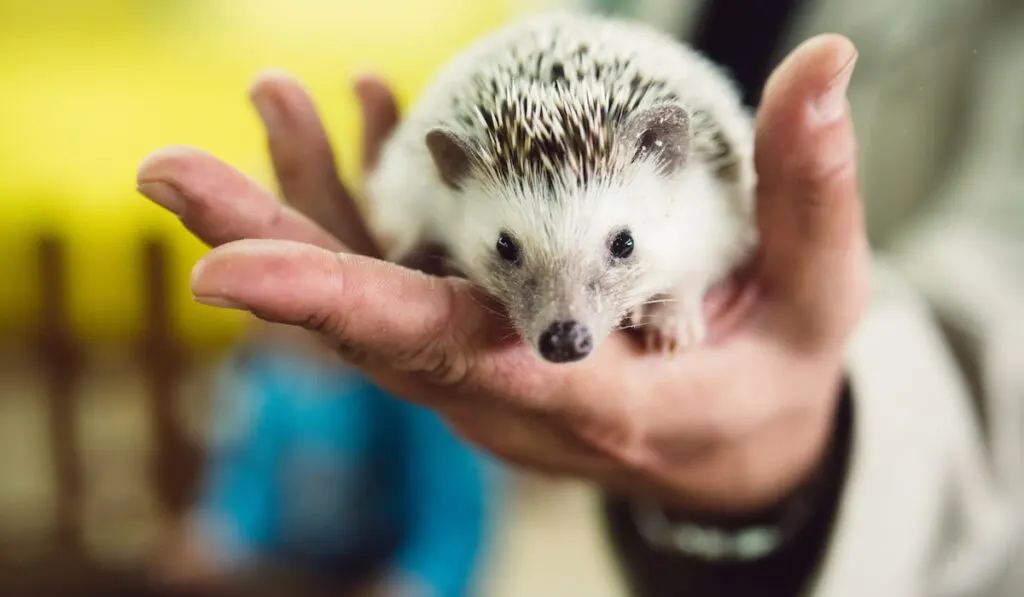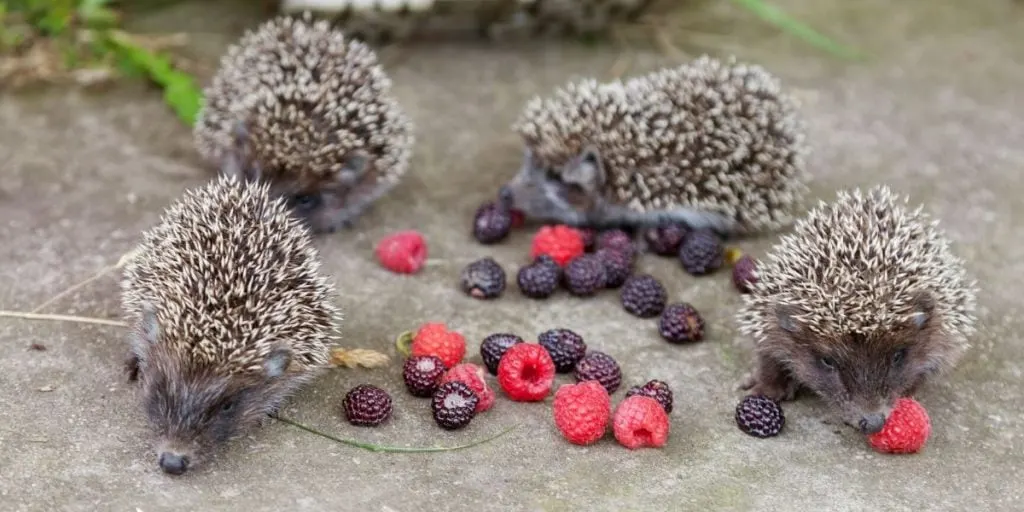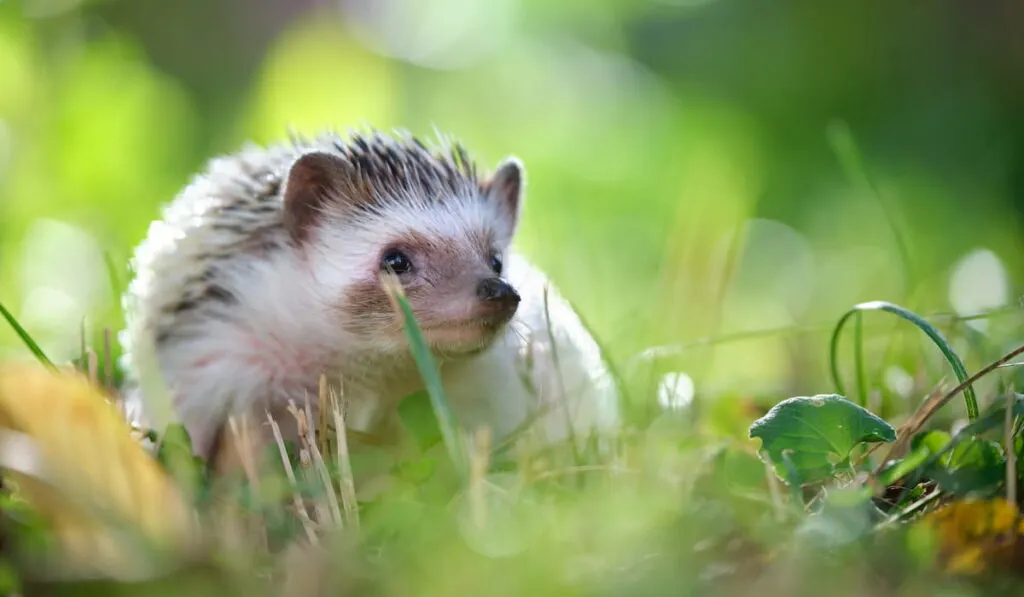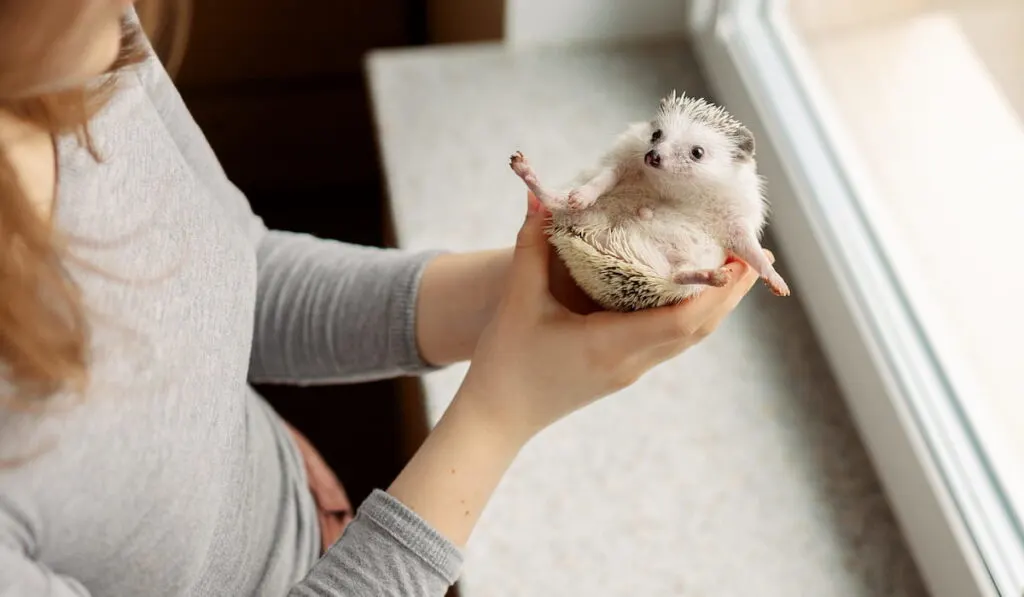Hedgehogs are cute. That is why so many people would want to get one as a pet. But there is more to having something that looks squishy and cuddly. Keeping a hedgehog as a pet also presents some challenges and entails a lot of responsibility and care.
How do you care for a pet hedgehog? Caring for a hedgehog is generally the same as caring for a dog or any other pet. You feed it the correct food, give it the proper housing, make sure it lives in a clean environment, and watch out for any disease.

It is the particulars, however, that make the difference. In this guide, we will talk about what to expect from hedgehogs, the specific kinds of food to feed them, the living conditions that suit them best, the standard medical and behavioral issues you’ll be dealing with, and everything else you would want to know about caring for these cute little creatures.
Table of Contents
What Kind of Animals Are Hedgehogs?
Hedgehogs are spiny mammals belonging to the subfamily Erinaceinae, in the Erinaceidae family. There are 17 species of hedgehog, and they were initially found in parts of Europe, Africa, and Asia.
They got their name from “hedge” because they frequent hedgerows and “hog” because of their pig-like snout.
The spines of a hedgehog are hollow hairs that are stiff because of keratin. These spines are not poisonous, and they don’t detach easily from their bodies.

Baby hedgehogs’ spines, however, fall out to give way to adult spines in a process called “quilling.” Adult hedgehogs also shed spines when they are extremely stressed or are sick.
A hedgehog has an average of 5,000 to 7,000 quills on its body. It can roll into a tight ball in self-defense mode, and when it does this, its spines or quills will point outwards. It also has two large back muscles that can control the position of these quills.
Reproduction and Lifespan
Hedgehogs have a gestation period of 35 to 58 days, depending on the species. On average, a litter for larger species is composed of three to four newborns, and for smaller ones, it’s five to six. It is not unusual for adult male hedgehogs to kill newborns that are male.
The average lifespan for hedgehogs is four to seven years for larger species and two to four years for smaller species. With a controlled diet and a lack of predators, they may live up to eight to 10 years. This lifespan is relatively long for an animal their size.
Newly born hedgehogs are blind. Their quills are covered with a protective membrane, and these dry out and shrink within the next several hours. New quills emerge through their skin after the old ones fall off.
How to Tell a Male Hedgehog from a Female Hedgehog
Most hedgehogs don’t want you turning them on their backs so you could get a good look under. This is their vulnerable area after all, and the reason they curl is to protect it. While baby hedgehogs are more amenable to being turned, it is often too early to work out whether they are male or female.
One trick used by breeders is by putting an adult hedgehog in a clear glass dish, like a Pyrex, so they get a better view of what’s under there.

A male hedgehog has a penile sheath found about halfway up its tummy. This penile sheath looks like a large bellybutton. A female hedgehog, on the other hand, has her sex organ directly adjacent to her anus. Both male and female hedgehogs have a row of nipples along each side of their tummy fur.
With baby hedgehogs, their bits are too small to indicate whether they are male or female. Also, the penis of a male baby hedgehog starts off in the same location as a female’s. As he grows, this bit slowly moves towards the chin.
Hedgehog Habits
While hedgehogs are basically nocturnal and sleep most part of the day, certain species are active during the daytime. Hedgehogs have habits that may vary across species. For instance, some are relatively vocal and can communicate through grunts, squeals, and snuffles.
These animals also occasionally perform an anointing, which is a ritual they do when they encounter a new scent. They will lick and bite the scent’s source, create a scented foam in their mouth, then paste this froth on their spines using their tongue.
Some experts believe that hedgehogs do this to camouflage themselves with the new scent and provide a possible poison or deterrent to predators pricked by their spines.
Hedgehogs are one of four mammalian groups known to have mutations that give them natural protection against snake venom. The other three being pigs, mongooses, and honey badgers. This can be attributed to the protein erinacin, which is present in their muscular system.
Hibernation
Some wild hedgehogs hibernate, depending on species, temperature, and the abundance of food in the environment.
During hibernation, a hedgehog’s body temperature can decrease to about 2 degrees Celsius or 36 degrees Fahrenheit. And when they wake up from hibernation, their body temperature rises back to its usual 30 to 35 degrees Celsius (86 to 95 degrees Fahrenheit).
Hedgehog As Pets
Most pet hedgehogs are African pygmy hedgehogs, which are hybrids of the four-toed or white-bellied hedgehog (Atelerix albiventris) and of the North African hedgehog. Other species that are suitable as pets are the Indian long-eared hedgehog (H. collaris) and the long-eared hedgehog (Hemiechinus auritus).
While hedgehogs have gained popularity as pets in the past several years, owning one as a pet is illegal in some American states, including California, Georgia, Hawaii, and Pennsylvania. In some municipalities in Canada, you will need a breeding license to own one.

Hedgehog Diet
Hedgehogs are omnivorous. In the wild, they eat a wide variety of plants, roots, and insects. They also feed on grass roots, carrion, mushrooms, berries, melons, watermelons, worms, earthworms, millipedes, caterpillars, snails, frogs, toads, bird eggs, baby mice, and even snakes.
In captivity, hedgehogs will thrive on a diet that is high in proteins and low in fats. You should also give them food rich in chitin, which is mainly produced by fungi, arthropods, and nematodes, and is a valuable fiber and a prebiotic.
What to Feed Pet Hedgehogs
The best diet for pet hedgehogs would be specially formulated hedgehog food or insectivore diet. You can get commercially available preparations of this in pet shops.
Most pet owners also feed their hedgehogs a staple diet composed of premium poultry-based cat food or cat biscuits with a 34 percent to 15 percent ratio of proteins to fats, or as close to that as possible.
Aside from specialized hedgehog food and high-quality dry cat food, African Pygmy hedgehogs can also eat high-quality dog food, lean meats, boiled or scrambled eggs, and baby food.
You should supplement your hedgehog’s main diet with treats like insects, moist cat food, fruits, and vegetables.
High-Protein, Low-Fat Diet
Unlike wild hedgehogs, Pygmy hedgehogs don’t hibernate, don’t forage for food, and don’t expend a lot of energy. As such, they tend to be greedy eaters and are prone to becoming obese. Because of this, owners have to mindfully regulate their feedings.
This is also the reason why many of the bugs that constitute a majority of a wild hedgehog’s diet should be given to pet hedgehogs only as treats.
Additionally, pet Pygmy hedgehogs should digest between 28 to 35 percent proteins and 12 to 15 percent fats. And since a protein-based diet with low-fat intake does not mean zero fat, you should maintain the amount of fat at 12 to 15 percent.
What Insects Can You Feed Your Hedgehog?
Insects are essential to a hedgehog’s diet because their exoskeletons are an excellent source of chitin. However, they are a hedgehog’s junk food and are good only as treats and should not compromise their staple diet.
Among a hedgehog’s favorites are mealworms and crickets. They also eat waxworms, beetles, millipedes, hornworms, maggots, and grasshoppers. When feeding your pet hedgehogs insects, you can go for live, freeze-dried, or canned insects.
You should also never give your pet hedgehog insects that you caught yourself or bugs you purchased from a bait-shop. These insects might carry parasites, bacteria, and toxins.
Hedgehogs are also selective eaters. So, in the combination of staple diet and insects, they would pick out the food that is the highest in calories. And this would quickly cause them to gain weight quickly.
What Fruits Can You Feed Your Hedgehog?

Pygmy hedgehogs can eat berries, papaya, kiwi, watermelon, peaches, bananas, apples, and cherries. However, some of these fruits contain a lot of sugar, and sugar can cause weight gain, as well as diabetes. So, you should give them these fruits as rarely as possible.
You should also never give your hedgehog grapes, raisins, or avocados. These fruits have been reported to be toxic to them.
What Vegetables Can You Feed Your Hedgehog?
Pet hedgehogs can eat green pepper, courgette, cucumber, broccoli, peas, leafy greens, corn, and carrots.
When giving your pet hedgehogs vegetables, make sure that these are diced. Harder vegetables like carrots should be cooked to make them softer. Peas and corn should be given to them in tiny amounts to avoid an imbalance in the Calcium/Phosphorus levels of their metabolism.
Moreover, you should not give your pet hedgehog starchy vegetables like potatoes, celery, and corn. Hedgehogs also don’t process vegetation very well.
What Kinds of Meat Can You Feed Your Hedgehog?
You can feed your hedgehogs a variety of cooked lean meats like chicken, beef, turkey, liver, lamb, and kidney. They should not be fed raw meat.
When you cook the meat, do not add seasoning and oil. You should also make sure that the meat you give your pet is cut, shredded, diced, or minced into fine pieces.
Food That You Should Not Give Your Hedgehog
Aside from the prohibited food mentioned above, you should also avoid giving your pet hedgehogs milk, bread, onion, citrus fruits, pineapple, chocolate, raw egg yolk, junk food, spicy food, dried fruits, and nuts and seeds.
While there are pet owners who give their hedgehogs crushed peanuts, they are considered to be a choking hazard as they tend to stick on the roof of their mouth.
How Much Food to Feed Your Pet Hedgehog
It is recommended that you feed your pet hedgehog one tablespoon of their staple food once or twice a day. However, pregnant, nursing, and baby hedgehogs are expected to eat more, so they should be given constant access to food. You should not forget to monitor them, though, and start regulating their intake once you notice weight gain.
As for treats, give them only small amounts so as not to spoil their staple diet. For instance, only give them up to two insects a day.
When is the Best Time to Feed Your Hedgehogs?
While some owners prefer a free feeding schedule, many owners would agree that the best time to feed hedgehogs is around twilight. This is because they are most active at night, and this is usually their wake-up time.
However, if you think your pet is acting hungry during the day, feel free to give it just a little bit more. Just make sure this does not cause unhealthy weight gain.
Hedgehog Exercise Needs
Hedgehogs are rather athletic creatures. In the wild, they would run several miles during the night. They are also excellent swimmers and climbers.
Pet hedgehogs are more restricted in their movements because they are usually in cages, so it is common for them to be overweight. This is why you should encourage exercise throughout their most active hours. One way to do this is by adding in a wheel where they can run. And if your enclosure is big, you can also hide treats in different places so that they actively search for it.

Hedgehog Housing
Part of successfully raising pet hedgehogs is providing a suitable enclosure for them. They are active little creatures that love exploring their living space and their territory, so their cage should be large. It should also be enclosed and secure, should have a ventilation system, and should be easy to clean.
Cage Dimensions
Ideally, your enclosure should have an area of at least 24 x 36 inches (2 x 3 feet). If you can afford a much bigger space, all the better. Your enclosure should have a wall about 16 inches high.
Additionally, you cage should have a closed top to make it secure. If you don’t have a closed top, make sure your hedgehog won’t be able to climb out. As such, wired sides could spell trouble.
Housing Requirements
Your hedgehogs should be in an enclosure with enough space to accommodate an exercise wheel and their natural foraging behavior. Moreover, it is recommended that it has smooth sides or interior walls to keep them from climbing and escaping. Hedgehogs have tiny legs and feet, so their house should have a solid floor, too.
The cage or enclosure should also have a hiding spot or a safety zone where they could sleep and have a “time-out” from light, prying eyes, and general activity. A sleeping pouch or an igloo will do the job.
Additionally, their house should have only one level. This is because they have poor eyesight, and their tiny legs easily break.
You should also include a space for their food bowls, their toys, and their litter tray. Make sure the enclosure is well-ventilated and has good airflow.
Housing Temperature
Because hedgehogs originated from tropical parts of the world, maintaining a slightly warmer temperature of 72 to 85 degrees Fahrenheit in their enclosure is ideal.
Cooler temperatures can induce an attempt at hibernation, which could lead to pneumonia and can be lethal. Hotter temperatures, on the other hand, can lead to heat stress.
As such, you must not forget to add an external heat source to your cage. This could be an under tank heater or a heat bulb. You should also throw in multiple thermometers so you can monitor the efficacy of your heating system.
In case there is a power outage, and the room temperature drops rapidly, especially during cold months, you should cover or wrap the enclosure with a blanket to keep it warm.
Proper Food Bowl and Water Bottle
When getting a food bowl, make sure it is wide enough for your hedgehog to access. The container also has to be heavy enough so it cannot tip over it and cannot play with it.
Fresh water should also be available always. If you are using a bowl for the water, make sure it is shallow and heavy enough that it doesn’t tip over. This bowl needs to be washed and filled with clean water every day.
If you are using a bottle with drinking tube, your hedgehog must know how to drink from it. You may need to show it how it’s done. The bottle also needs to be cleaned and refilled with fresh water daily to prevent the build-up of bacteria.
Bedding Material
Hedgehogs love to sleep on a bed of wood shavings. Aspen shavings are preferable to cedar as the latter can emit aromatic oils that may cause cancer. As an alternative, you can line the bed with fleece, corduroy, or twill.
Be sure to keep the bedding far from your hedgehog’s water. The bedding should be changed once a week, or as often as needed.
Litter Tray
Your hedgehog’s little tray should have no more than a half-inch lip for easy access and to prevent broken legs. The litter pan should be large enough for your hedgehog. You can use a commercial plastic litter box or a cookie sheet.
If you decide on using litter, get only non-lumping kitty litter. Alternatively, you can use paper towels.
Toys for Hedgehogs
Aside from a running wheel with a solid floor, there are other toys that your hedgehog can play with to encourage some sort of exercise. They are particularly fond of playing with items they can chew, nuzzle, tip over, and push. These include rubber balls, rubber figures, baby teething rings, empty toilet paper tubes that are vertically cut in half, bird toys with bells, and cat balls.
Ideal Environment for Hedgehog
Keep your hedgehog in a peaceful and quiet place. Remember that it is naturally a prey animal, so it depends on its sense of hearing. Too much noise in the room and too much activity may be distressing for your pet.
Aside from keeping noise levels at a minimum, lighting levels in the vicinity should also be kept low.
Hedgehog Interaction and Handling
Hedgehogs have a very solitary nature. In the wild, they only socialize when it is mating season. The same goes for when they are in captivity. As such, they should be kept in separate cages or housing units.
This solitary nature is also the reason why hedgehogs take a while to warm up to their owners. However, with time and patience, pet owners would eventually earn their trust.
Experts advise that the best way for you to train a hedgehog to accept handling is by getting it from a breeder while it is young. It is also essential that you allow your new pet some time to settle into its new home. This means giving it a few days where you leave it be.
Once your pet is more settled in, you can start handling it a little at night while it is awake. Allow your hedgehog to get familiar with the scents of your hands. Be careful, though, because hedgehogs bite when they startled.
How to Handle and Play with a Hedgehog

Frequent handling would eventually lead to a hedgehog’s familiarity with being held. Don’t think of it as fragile so that you can confidently handle your pet. The general rule for handling is to do it at least 30 minutes each day.
When you are about to handle a hedgehog, start by approaching it slowly and quietly. Pick it up from underneath and hold it cupped in both of your hands.
You should also take time to play with your pet. It will accept your involvement in play if you regularly join in.
Cleaning and Bathing
Make sure to clean out your hedgehog’s cage or enclosure at least once a week. Clean the feeding bowls, the wheel, the bedding, and the litter. Get rid of old food and feces, and clean the hiding spot, too.
You should also give your hedgehog an occasional bath. However, if your pet does not like baths, you should avoid bathing it unless it’s filthy. You wouldn’t want to put it under too much stress and trauma by forcing bath time on it.
How to Bathe Your Hedgehog
Fill your sink with warm water to the level of your hedgehog’s tummy. Make sure that the water does not get into its nose or ears.
Add a mild puppy bath or oatmeal bath to the water. Brush out its quills and feet with a toothbrush.
Rinse your hedgehog with warm water. Snuggle to dry with a clean and dry towel. If your pet can tolerate it, you can also use a hairdryer. Remember not to put your hedgehog back in the cage while it is still wet.
Your hedgehog’s nails should be trimmed regularly, too. If they get too long and start curling around, they can easily get ripped off while running on the wheel. Use small manicure scissors to trim off the tips. If a little bleeding occurs, simply dab some cornstarch on the spot using a Q-tip.
Hedgehog Health Care
Take your hedgehog to a veterinarian every year so you could identify potential health issues early.
Hedgehogs may acquire a variety of cardiac conditions and cancerous diseases. But with an annual veterinary checkup and with early detection, your hedgehog will be able to live a long and good-quality life.
For those who don’t intend to breed hedgehogs, it is recommended that females be spayed. Spaying can help eliminate the risk of uterine tumors, which female hedgehogs are prone to developing.
Watch for Common Diseases
As soon as you get a hedgehog, take it to the veterinarian for an exam. It will be checked for both internal parasites like worms and external parasites like mites and fleas.
Hedgehogs are also prone to diarrhea and pneumonia. If you suspect that your pet may be sick, take it to a vet.
Other diseases that are common to hedgehogs include fatty liver disease due to improper diet, heart disease, and squamous cell carcinoma or cancer. If your hedgehog is losing spines, it is a good indicator that it may be sick.
When Temperature is Too Warm or Too Cold
If you see your pet spread out in its cage or enclosure as if it is hot, adjust the temperature and keep it cooler.
Meanwhile, if your pet is lethargic or if its body temperature is cooler to the touch than usual, it needs more warmth. Put it under your shirt immediately and use your body heat to make it warmer.
If your hedgehog still feels cool after an hour, then take it to the veterinarian.
How to Know Your Hedgehog is Overweight
Make sure you hedgehog is not overweight. You will know it is overweight when it cannot roll up and it has “bags” of fat hanging down the armpit area and affecting its ability to walk.
Once you notice these signs, reduce the amount of food you are feeding it and increase exercise.
Final Thoughts
We hope this guide provides the information to confidently take care of your pet hedgehog.
Resources:
When learning about hedgehogs and their needs, it is important to learn from a wide variety of sources. These are the sources used in this article.
- https://vetmed.illinois.edu/pet_column/hedgehog-pets/
- https://www.wikihow.com/Take-Care-of-a-Hedgehog
- https://pethelpful.com/exotic-pets/raising-hedgehogs
- https://www.goodhousekeeping.com/life/pets/g20706693/how-to-care-for-a-pet-hedgehog/
- https://en.wikipedia.org/wiki/Hedgehog
- https://www.exoticdirect.co.uk/news/what-can-pygmy-hedgehogs-eat-best-diet-your-pet-hedgehog
- http://www.hedgehog-rescue.org.uk/sexing.php
